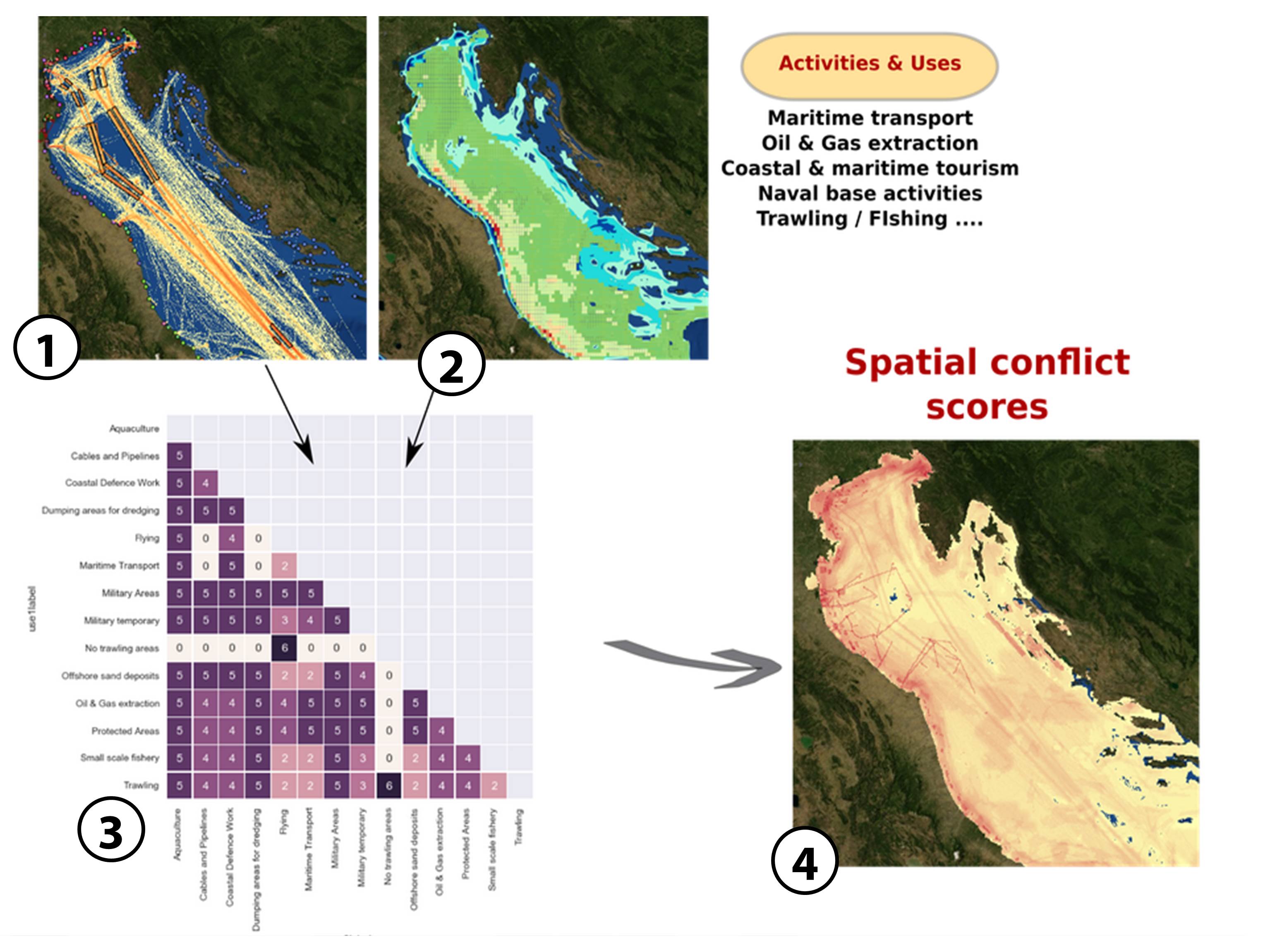Tools4MSP Geoplatform - legacy/deprecated version
Feb. 10, 2023, 11:25 a.m.
COEXIST - Sea Uses Conflict Analysis
Aim
The COEXIST – sea uses conflict analysis tool was developed during ADRIPLAN project. The tool is based on a methodology developed for the FP7 COEXIST Project and has the aim to (1) support MSP process through reallocation of maritime uses, (2) creation of collaborative conflict scores analysis; (3) iteration of the analysis over different time periods trough integration of new conflict scores and geospatial datasets on sea uses, (4) sea use scenario analysis and (5) overlay analysis.

Figure 1. Stepwise methodological approach for the The COEXIST – sea uses conflict analysis.
The stepwise methodology implemented in the COEXIST – sea uses conflict analysis can be described as follows (see also Figure 1):
- Step 1:
- Identification and collection of relevant sea use datasets.
- Step 2:
- Normalization of use layers on a 1 km2 grid size using the European Environmental Agency Reference Grid (EEA, 2012).
- Step 3:
- Expert based definition of spatial and temporal attributes (vertical domain; activity spatial domain; activity temporal domain; mobility) and calculation of “conflict score” for sea use pairs located in the same cell.
- Step 4:
- Geospatial visualization of spatial conflict scores, representing the potential spatial and temporal conflict between sea uses.
Outputs
The main outputs of the tool are the following:
- Quantification and visualization of overlapping sea uses by considering current and future sea use scenarios.
- Generation of statistical outputs (plots and tables) to inform on sea use contribution to conflict scores.
- Analysis of data gaps in terms of data availability, quality and geospatial extent based on data availability maps and statistical outputs.
References and further reading
ADRIPLAN, 2016. ADRiatic-Ionian Marine Spatial PLANning. Web: http://adriplan.eu/, accessed 23/09/2016.
ADRIPLAN Data Portal, 2016. Web: http://data.adriplan.eu/, accessed 23/09/2016.
ADRIPLAN Data Portal Guidelines, 2016. Web: http://data.adriplan.eu/documents/?limit=20&offset=0, accessed 23/09/2016.
Barbanti, A., Campostrini, P., Musco, F., Sarretta, A., and Gissi, E. (2015). Developing a Maritime Spatial Plan for the Adriatic Ionian Region. CNR-ISMAR, Venice, IT.
EEA, 2012. EEA reference grid. Web: http://www.eea.europa.eu/data-and-maps/data/eea-reference-grids-1, accessed 23/09/2016.
European MSP Platform, 2016. Adriplan conflict score tool. Web: http://msp-platform.eu/practices/adriplan-conflict-score-tool, accessed 23/09/2016.
Menegon, S., and Sarretta A., 2016. Development and integration of geopython tools to support integrated coastal management and Marine Spatial Planning. Geopython Conference, 2016. Presentation Muttenz, June 24, 2016. Web: http://menegon.github.io/presentations/geopython2016/#/, accessed 23/09/2016.
Menegon S, Sarretta A, Barbanti A, Gissi E, Venier C. (2016). Open source tools to support Integrated Coastal Management and Maritime Spatial Planning. PeerJ Preprints 4:e2245v2 https://doi.org/10.7287/peerj.preprints.2245v2
Any question?
Tools 4 MSP groupCNR - Institute of Marine Sciences
Email: tools4msp[at]ismar.cnr.it